Yucatan Venomous Snakes
Information and Photo Guide:
Among the multiple
snake species found at the Hacienda Chichen Resort private
Maya Jungle Reserve and grounds, you will find five endemic
venomous snake species:
Yucatan
Neotropical Rattlesnake: Tzabcan
Yucatecan
Cantil
Yucatan
Hognose Pitviper
Yucatan's Coral Snake Group
plus the impressive Nauyaca Real,
Fer-de-lance
venomous snake species:
Nauyaca Real or Terciopelo Pitviper,
Taxincan
Hacienda Chichen Resort, in Chichen Itza, Yucatan, is
committed to preserve and protect the vast variety of its
property's flora and fauna. These efforts, make this
boutique Spa hotel a unique place in the Yucatan to enjoy an
Eco-Cultural vacation, especially for nature lovers and
those that wish to have an intimate contact with Mother
Nature and the Maya world.
In the
Yucatan Peninsula there is 134 snake species recorded to
date. Almost 20% of them are endemic, which means they are
only found in the Yucatan. In
Chichen Itza, you will find over 12 endemic snakes
species, most are endangered or at risk, due to human
hunting and intense deforestation of their habitat.
Four of the protected snakes found in the Hacienda Chichen
Resort grounds are highly venomous, and visitors need to
take care not to disturb these snakes by carefully observing where
they walk and step.
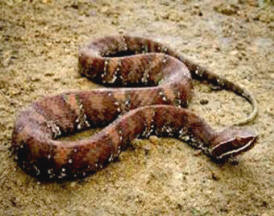
These
Venomous Snakes are protected in our property to help preserve them
as part of the Maya native fauna, which is in grave danger due to
the misconceptions and fears that have been instilled for
generations.
To contemporary Maya people, all snakes are dangerous and must be killed;
sadly, although not all snakes are poisonous, Maya people in
Yucatan treat them as such.
We have to accept that living with snakes
in Yucatan’s jungle
regions is a way of life and killing them is not responsible
management of nature, and killing them only should be a last
recourse under specific circumstances. It is important to
remember that while these snakes can be lethal, they would rather escape than confront a human;
thus, getting out of their way is the safest tactic. Anti-venom
medicine is applied at the local emergency clinic, but it is best to
avoid getting bitten altogether.
Prevention is always better than a cure; it
makes sense to take precautions to avoid snakebites in the first
place. These snakes will snap and attack defending their own safety
and territory; they will react with bites if they perceive they are
under attack or in danger. When encoutering a snake, it is not recommended you try to kill the
snake yourself, it is best you calmly and gently back away from the
area.
SAFETY RECOMMENDATIONS: When
strolling through the Maya Jungle Reserve and open grounds around
Chichen Itza and any other ancient Maya archeological zone:
-
Use boots rather than sandals and stay
within marked paths when ever possible..
-
Avoid walking in the evergreen vine
Epipremnum aureum spread throughout Hacienda Chichen's lush gardens, this vine called “Telefono” in Spanish, and “Ivy Arum” in English.
-
Don’t walk at night without a flash light.
Use your cellular phone light or other light.
-
Use caution, make sure you have observed
the area well before you step into it.
-
Remember, many snakes camouflage well in
dried leaves and twigs piles.
If you see a snake cautiously walk away and do not bother,
disturb, or agitate it.
-
If you see a snake within the Hacienda
Chichen's grounds, call one of our staff members to have it
safely removed and relocated for everyone's safety: yours, ours
and the snake's.
Yucatan Venomous Snakes
Information and Photo Guide:
Three of our venomous snakes
belong to the Viperidae Family; they have, at the root of
their mouth, a pair of long retractable fangs to inject their lethal
venom to their victims.
"Yucatan
Neotropical Rattlesnake: Tzabcan"
Crotalus simus tzabcan
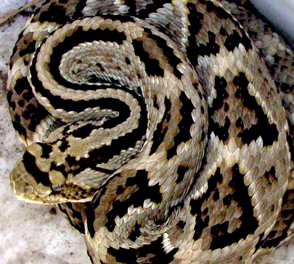 Ancient Maya greatly revered this snake and they built numerous temples
with columns and carvings depicting the Yucatan Neotropical
rattlesnake,
a member of the subspecies Crotalus simus tzabcan,
which became a new subspecies since 2004. This pitviper's other scientific name is
Crotalus durissus tzabcan.
This species is native to
the Yucatan Peninsula, Belize and northern Guatemala. This
venomous Tzaban pit viper species is found in our private
Maya Jungle Reserve and grounds.
Ancient Maya greatly revered this snake and they built numerous temples
with columns and carvings depicting the Yucatan Neotropical
rattlesnake,
a member of the subspecies Crotalus simus tzabcan,
which became a new subspecies since 2004. This pitviper's other scientific name is
Crotalus durissus tzabcan.
This species is native to
the Yucatan Peninsula, Belize and northern Guatemala. This
venomous Tzaban pit viper species is found in our private
Maya Jungle Reserve and grounds.
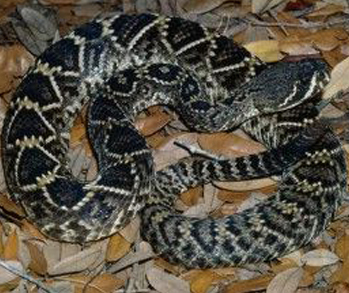 The word Tzabcan means
rattlesnake in Yucatec Maya. In Spanish it is commonly referred to
as Serpiente o Vibora de Cascabel.
This pit viper prefers
semi-arid areas, hides in piles of dried twigs and leaves, or lays
in grasslands
where they can camouflage.
The word Tzabcan means
rattlesnake in Yucatec Maya. In Spanish it is commonly referred to
as Serpiente o Vibora de Cascabel.
This pit viper prefers
semi-arid areas, hides in piles of dried twigs and leaves, or lays
in grasslands
where they can camouflage.
This terrestrial pit viper is largely nocturnal and territorial.
Adults can exceed over three meters in length and have thick bodies.
They feed on small mammals, reptiles, and eggs.
Currently, there is a
possibility that this rattlesnake is an endangered species due to
human persecution, be it for fear or for shamanic medicinal
traditions.
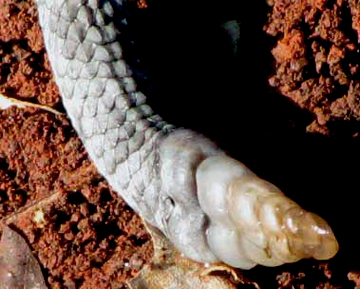 Yucatan Neotropical
rattlesnakes' crown scales (at their broad heads) are small and form two
long parallel lines extending to their necks. Like all rattlesnakes,
the Yucatan Neotropical rattlesnake vibrates its horny ringed tail, which produce a hissing sound when
agitated. The rattles are formed at the tip of the tail, from the
first time they shed their skin, due to a blunt segment called prebuttom.
These pit vipers shed
their skin up to 4 times a year.
Yucatan Neotropical
rattlesnakes' crown scales (at their broad heads) are small and form two
long parallel lines extending to their necks. Like all rattlesnakes,
the Yucatan Neotropical rattlesnake vibrates its horny ringed tail, which produce a hissing sound when
agitated. The rattles are formed at the tip of the tail, from the
first time they shed their skin, due to a blunt segment called prebuttom.
These pit vipers shed
their skin up to 4 times a year.
These endemic
rattlesnakes' scales form diamond shaped patterns along their dorsal body.
Within the area of Chichen Itza, the Tzabcan rattlesnakes can
be colored
black with gray and white, or brown with tan and reddish
tones. Regardless of the skin coloration, these venomous
rattlesnakes are highly aggressive if disturbed.
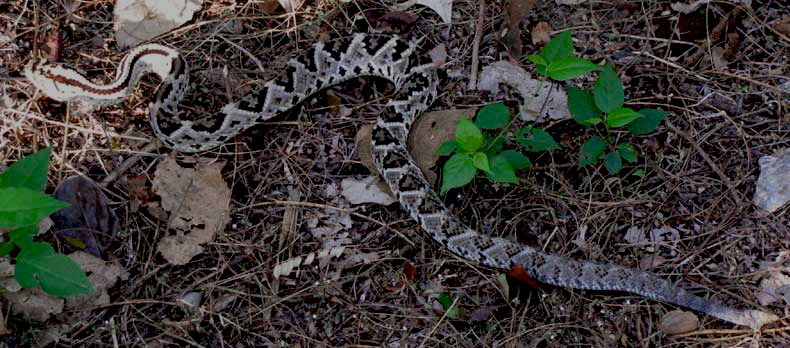
The Tzabcan bite
symptoms include progressive paralysis and requires immediate
medical attention. Hemorrhaging may be present at the bite site, but what
is most serious is the neurotoxic symptoms produced by the venom.
This is why you should always avoid getting bitten by carefully,
visually inspecting the area you are stepping on and avoid passing
nearby or to close to one these pit vipers.
"Yucatecan Cantil: Uol-poch"
Agkistrodon
bilineatus russeolus
This
is truly a venomous pit viper species, found in Yucatan and Central
America. Common names are Cantil, Mexican moccasin, and yellow-lipped
pit viper in English. The Cantil name comes from the Maya Tzeltal
people living in Chiapas, it means “yellow lip.”
The Yucatecan Cantil, is endemic protected species of the Yucatan
and the fourth subspecies A. b. russeolus of
the genus Agkistrodon bilineatus.
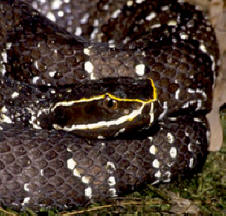 Yucatecan
Cantil pit vipers are called Uol-poch
in Yucatec Maya. These venomous pit vipers are generally shy by
nature, and their first
instinct is to flee danger. Only when threatened, a
Uol-poch will display
rapid aggressive behavior and will move to strike. These short and
thick bodied venomous pit vipers can reach 120 cm. Cantil pit vipers share some general body
structures with cottonmouth snakes, such as a triangular shaped head
with small eyes and vertical pupils. Uol-poch or
Yucatecan Cantil's neck area is slimmer than the body width.
Yucatecan
Cantil pit vipers are called Uol-poch
in Yucatec Maya. These venomous pit vipers are generally shy by
nature, and their first
instinct is to flee danger. Only when threatened, a
Uol-poch will display
rapid aggressive behavior and will move to strike. These short and
thick bodied venomous pit vipers can reach 120 cm. Cantil pit vipers share some general body
structures with cottonmouth snakes, such as a triangular shaped head
with small eyes and vertical pupils. Uol-poch or
Yucatecan Cantil's neck area is slimmer than the body width.
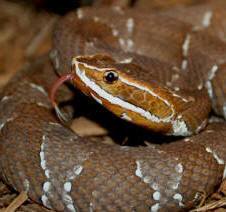 Their dorsal pattern coloration varies between black and dark brown
with banding. Their skin pattern displays tan to white color scale
accents. Two yellow upper head lines that pass above the eyes to the
nostril distinguish them clearly, (see photo). Under their lip a
broader white line flows from the nasal to the lower jaw. As
Yucatecan Cantil
ages, its pattern and coloration fade and darkens. Juvenal Cantil
snakes display a colorful tail tip, from deep yellow to golden
green. Both are found within the private Maya Jungle
Reserve at Hacienda Chichen, Chichen Itza, Yucatan, Mexico.
Their dorsal pattern coloration varies between black and dark brown
with banding. Their skin pattern displays tan to white color scale
accents. Two yellow upper head lines that pass above the eyes to the
nostril distinguish them clearly, (see photo). Under their lip a
broader white line flows from the nasal to the lower jaw. As
Yucatecan Cantil
ages, its pattern and coloration fade and darkens. Juvenal Cantil
snakes display a colorful tail tip, from deep yellow to golden
green. Both are found within the private Maya Jungle
Reserve at Hacienda Chichen, Chichen Itza, Yucatan, Mexico.
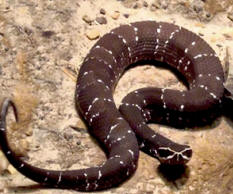 They will attack if
provoked, or threatened, by tightly coiling their bodies and raising
the last several inches of its tail, which quickly flicks, creating loud noise when angered.
Simultaneously, the Cantil will open its mouth as one last warning, before striking. This highly
poisonous pit viper can leap long lengths upwards of a couple of
meters. Breeding occurs normally during spring as most other viper
species do. Cantil pitvipers are ovoviviparous, giving birth to
five / twenty young at a time. They
are nocturnal and pray on small mammals, lizards, and other snakes.
They will attack if
provoked, or threatened, by tightly coiling their bodies and raising
the last several inches of its tail, which quickly flicks, creating loud noise when angered.
Simultaneously, the Cantil will open its mouth as one last warning, before striking. This highly
poisonous pit viper can leap long lengths upwards of a couple of
meters. Breeding occurs normally during spring as most other viper
species do. Cantil pitvipers are ovoviviparous, giving birth to
five / twenty young at a time. They
are nocturnal and pray on small mammals, lizards, and other snakes.
Uol-poch or Yucatecan
Cantil pitvipers are truly feared by
Maya people, due
to the powerful venom: it causes painful edema, serious hematuria,
shock, respiratory difficulty, and tissue necrosis with potential
fatal results. If bitten by a Cantil, you must seek medical care
immediately to avoid amputation or even death.
"Yucatan Hognose Pitviper"
Porthidium
yucatanicum also know as Trimeresurus yucatanicus
Called Chac can in
Maya, and Nauyaca nariz de cerdo yucateca in Spanish, the
Yucatan Hognose pitviper,
Porthidium
yucatanicum also Trimeresurus yucatanicus, is an endemic
terrestrial and nocturnal pit viper of the
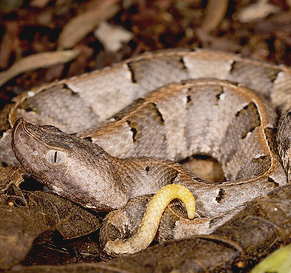 Yucatan Peninsula,
Mexico. Its territory extends through two thirds of the peninsula,
including the deep undisturbed deciduous forest areas around Chichen
Itza's monte or jungle grounds. Currently, no subspecies is
recognized for this terrestrial viper. It is protected by Mexican
law under the Conservation Actions Law, as its population is
dangerously in decline. The Yucatan Hognose Pitviper is endangered due
to the “milperos” or Maya farmers increase depravation and
encroaching its habitat by deforestation vast areas of the jungle. There
are few, if any, studies published on
this Yucatan endemic hognose pit viper.
Yucatan Peninsula,
Mexico. Its territory extends through two thirds of the peninsula,
including the deep undisturbed deciduous forest areas around Chichen
Itza's monte or jungle grounds. Currently, no subspecies is
recognized for this terrestrial viper. It is protected by Mexican
law under the Conservation Actions Law, as its population is
dangerously in decline. The Yucatan Hognose Pitviper is endangered due
to the “milperos” or Maya farmers increase depravation and
encroaching its habitat by deforestation vast areas of the jungle. There
are few, if any, studies published on
this Yucatan endemic hognose pit viper.
Adult males
usually reach 45 cm in length, and females are larger, at about 55
cm. Both are short in length and heavily built with short tails. In
the Juvenile Yucatan hognose pit vipers, the tail is clearly yellow
and coloration fades as it ages. Their heads have a distinctive
triangular shape and their neck is a bit narrower. The eyes are
elliptical and moderately small, with vertical pupils. The Chac
ca body
scales coloration can have a gray to light brown tan with frequent
hints of orange tones. Their spine has a distinctive orange golden
line and patches of darker tan and brown patterns, with black areas
border lighter bands. As most viviparous pit vipers, they breed in
the spring giving birth from July to Aug. They are highly venomous,
preying on small mammals, reptiles, and eggs.
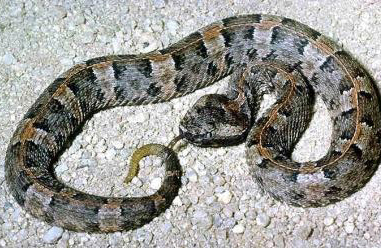
Do not approach this or any other snake while
visiting the ground of
Hacienda Chichen's private Maya Jungle Reserve in Chichen Itza
The Yucatan Hognose pit
viper is greatly feared by all Maya rural people, because it is a
highly venomous snake. It has killed many rural people while they
cleared their fields for
milpas. Its venom causes painful edema, serious hematuria,
shock, respiratory problems with change of pulse rate and weakness,
nausea and vomit may occur, retina hemorrhage and convulsions has
been reported. We ask Hacienda Chichen staff, guests, and visitors
to the area NOT to confront this or
any of these endemic pit vipers, and take
special care when walking in our Maya jungle nature reserve
grounds and hotel gardens, avoid accidental encounters with these
endangered venomous snake species. The Cha ca, as known by the Maya
people, has an important place in the regions ecosystem and as
stated before, it is protected by Mexican laws.
"Yucatan's Coral Snake Group"
Variable Coral
Snake, Micrurus diastema
Mayan Coral Snake, Micrurus hippocrepis
Central America Coral Snake, Miscrurus nigrocinctus
Coral Snakes belong to the
Elapidea family; these are the one of the most venomous snakes found in
Yucatan, Mexico. Coral snakes, like other members of this family,
have short fixed fangs that inject lethal toxins to the victims
nervous system when bitten.
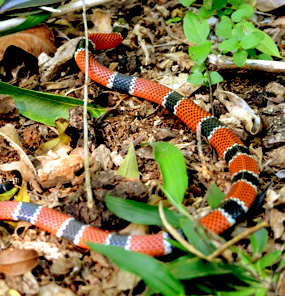 There
are 50 Coral snake species around the world; only three of
them are found in Yucatan. These Coral snakes are venomous
elapid, thin colorful snakes found fromYucatan to parts of
Central America. These three coral snake
species reside in the Yucatan
Maya forest and are also found in
Chichen Itza's archeological grounds and
within the Hacienda Chichen's Maya Jungle Nature Reserve.
There
are 50 Coral snake species around the world; only three of
them are found in Yucatan. These Coral snakes are venomous
elapid, thin colorful snakes found fromYucatan to parts of
Central America. These three coral snake
species reside in the Yucatan
Maya forest and are also found in
Chichen Itza's archeological grounds and
within the Hacienda Chichen's Maya Jungle Nature Reserve.
All elapid snakes are
characterized by hollow, fixed fangs through which they inject
venom. Coral snakes are very dangerous venomous elapids that can be
seen during the day moving under dry leafs (see photos). They are
many times difficult to spot and we recommend you carefully inspect
the ground you step
in, as these snakes tend to move under dried vegetation. The Maya
and other Coral snakes can be distinguished from a number of
similarly colored harmless snakes by the fact that they are 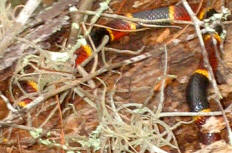 the only
ones with red bands touching yellow ones (left photo). The body is
ringed with transverse bands of black, red, and yellow vivid colors;
note bands length varies. Their dorsal scales are smooth and shinny.
Note that their yellow transversal band touches the red band, an
indication that you are observing a true coral snake. Maya coral
snakes are infrequently encountered because of their burrowing
habits, and they seldom bite unless molested and handled.
the only
ones with red bands touching yellow ones (left photo). The body is
ringed with transverse bands of black, red, and yellow vivid colors;
note bands length varies. Their dorsal scales are smooth and shinny.
Note that their yellow transversal band touches the red band, an
indication that you are observing a true coral snake. Maya coral
snakes are infrequently encountered because of their burrowing
habits, and they seldom bite unless molested and handled.
The venom of coral snakes,
like that of cobras, acts on the nervous system and causes
paralysis; the mortality rate among humans who are bitten (snake
chews rapidly) is high due to the strong neurotoxin venom its small
fangs inject to the victim. Their teeth are very small and
will not brake through thick leather hiking boots or other hard
leather shoes. They feed on other snakes and lizards.
"Not a Coral Snake but a
Look Alike "
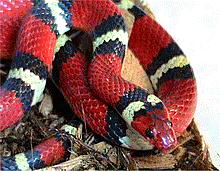 The
Coral snakes should not be confused with the non-harmful
non-venomous Blanchard's Milk Snake, lampropeltis
triangulum blanchardi, from the Scarlet King snake species
family, which is also native to the Yucatan and found in the
Hacienda Chichen property. This snake mimics the colors and
transverse banded skin patterns of Coral snakes, and also displays
smooth shinny scales, but it can be distinguished by observing the
transverse band color sequence, because the red bands do not touch
the yellow bands but follow the black ones. Scarlet King
snakes are not venomous but is best to avoid getting close to them
as you can forget this change of band colors. This snake is a
constrictor to kills its pray; they will eat other snakes, lizards,
birds, and small mammals.
The
Coral snakes should not be confused with the non-harmful
non-venomous Blanchard's Milk Snake, lampropeltis
triangulum blanchardi, from the Scarlet King snake species
family, which is also native to the Yucatan and found in the
Hacienda Chichen property. This snake mimics the colors and
transverse banded skin patterns of Coral snakes, and also displays
smooth shinny scales, but it can be distinguished by observing the
transverse band color sequence, because the red bands do not touch
the yellow bands but follow the black ones. Scarlet King
snakes are not venomous but is best to avoid getting close to them
as you can forget this change of band colors. This snake is a
constrictor to kills its pray; they will eat other snakes, lizards,
birds, and small mammals.
" Nauyaca Real or Terciopelo Pitviper: Taxinchan"
Bothrops asper
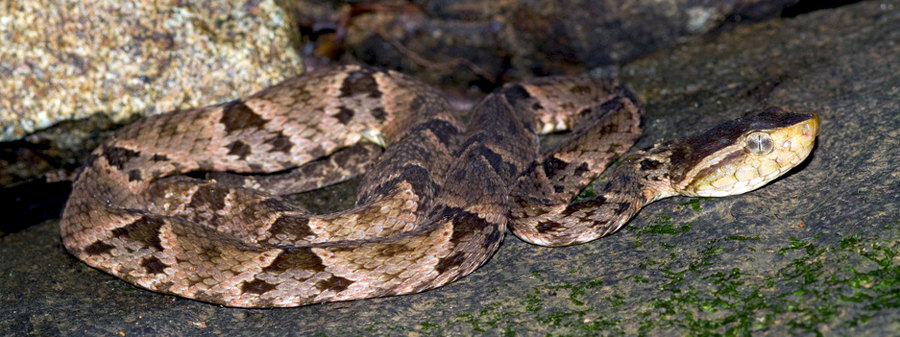
Called "Taxin'can,
Taxinchan" in
Yucatec Maya, and "Nauyaca Real, Terciopelo, Barba Amarilla,
Cantil Boca Dorada" and other names in Spanish; also commonly
named "Fer-de-lance" in English, the Nauyaca Real pitviper,
Bothrops asper belongs to the Viperidae Family,
subfamily Crotalinae. This impressive pitviper is found
in Mexico, Central and the upper region of South America.
The Nauyaca Real is
considered the ultimate pit viper, and the most dangerous venomous
snake in Yucatan. This impressive venomous snake is one of the
most dimorphic species found in Yucatan: Males can reach 1.80 meters
in length; females grow larger, over 2.5 in length. Usually these
vipers' dorsal scales are keeled and have gray or brown color
shades, some even have a soft pink tone in their scale keeled
pattern with interchanging gray scales creating dark triangles and
paravertebral blotches.
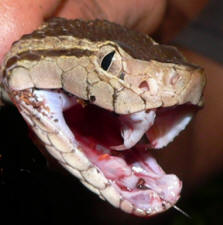
The Nauyaca Real female's
body is robust, could reach 16 pounds or more; their heads can be
three times larger than the males, normally 4 inches wide; the
mature female's fangs typically reaches an inch in size. Both sexes'
head is broad, lance shaped and flattened when view from above; the
head sides and bottom is covered typically with yellow scales, which
gives this snake another popular name: Barba Amarilla. Eyes
are medium size with vertical elliptic pupils.
A viviparous species that
can bear five to eighty young at a time. Growing young
snakes exhibit caudal luring to prey, thought only males have bright
colored tail ends; both young feed on small vertebrates; adults
specimens feed on small mammals, lizards, iguanas, frogs, and birds.
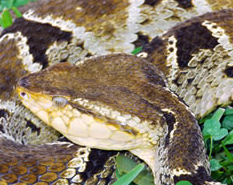 Mainly
a solitary nocturnal pitviper; this fast moving and excitable
venomous snake camouflages well with its surroundings. The
Nauyaca Real is very aggressive if threatened or disturbed;
thus, it is best to avoid getting nearby the area around it. When
threatened, it can display an "S" coiled form and attack rapidly.
This Bothrops asper pitviper is responsible for the majority
of lethal snake bites in Central America. If bitten, an
anti-venom treatment is immediately a must. However deadly,
the Nauyaca Real are, they serve as an important part of the
Neotropical ecosystem living equilibrium and are protected in the
Maya Jungle Reserve of the Hacienda Chichen, in
Chichen Itza,
Yucatan, due to the intensive hunting and killing by Maya rural
people in the region. Guests are required to use extreme caution
when strolling the grounds of the reserve, use boots and avoid night
walks in the jungle grounds. When spotting this and other
snakes, it is best to move carefully away from the area, not disturb
them, and follow our caution tips.
Mainly
a solitary nocturnal pitviper; this fast moving and excitable
venomous snake camouflages well with its surroundings. The
Nauyaca Real is very aggressive if threatened or disturbed;
thus, it is best to avoid getting nearby the area around it. When
threatened, it can display an "S" coiled form and attack rapidly.
This Bothrops asper pitviper is responsible for the majority
of lethal snake bites in Central America. If bitten, an
anti-venom treatment is immediately a must. However deadly,
the Nauyaca Real are, they serve as an important part of the
Neotropical ecosystem living equilibrium and are protected in the
Maya Jungle Reserve of the Hacienda Chichen, in
Chichen Itza,
Yucatan, due to the intensive hunting and killing by Maya rural
people in the region. Guests are required to use extreme caution
when strolling the grounds of the reserve, use boots and avoid night
walks in the jungle grounds. When spotting this and other
snakes, it is best to move carefully away from the area, not disturb
them, and follow our caution tips.
In Yucatan, at the
Hacienda Chichen's Maya Jungle Reserve, the Nauyaca Real, Terciopelo
pitvipers, inhabit close to human rural zones, "milpas" agricultural
disturbed deciduous tropical forests, lowlands, and close to
cenotes. Enjoys hidden
among leaf litter and roots to sleep, as well as basting in the sun
during the day.
You may wish to read our interview to
Jim Conrad, a naturalist that has written many
articles about the fauna and flora found at Hacienda Chichen Resort
here.
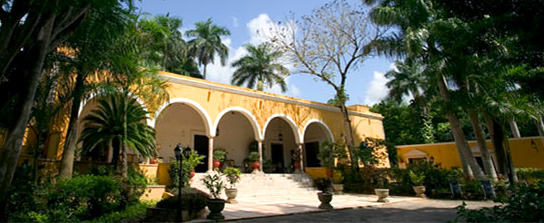
Yucatan flora: Cycads at Hacienda
Chichen Eco-Spa Resort, Chichen Itza, Yucatan, Mexico:
Yucatan Adventure Green
Travel Guide is a volunteer Sustainable Green Travel Guide designed
by the Maya Foundation In Laakeech A. C. a NGO sustainable civil
society founded by Hacienda Chichen Resort's owners and staff in
Chichen Itza, Yucatan, Mexico. Hacienda Chichen's
sustainable green vision and eco-cultural mission committed to
provide travelers a soulful Mayan cultural experience as well as a
Green Getaway to explore the eco-wonders and cultural traditions of
the Maya; as well as to support the welfare of
Mayan rural communities and to promote
Sustainable
Geo-Tourism. Visit Hacienda Chichen Resort and
Yaxkin Spa's website:
www.haciendachichen.com
Enjoy
Hacienda
Chichen Resort's Flora Guide and Botanical Gardens beauty and
serenity when visiting Chichen Itza, Yucatan, Mexico.
Published Photos &
Information Courtesy of
Hacienda Chichen Resort and Mr. Jim Conrad
Maya Foundation In Laakeech A.C. Volunteer.
Sept. 2016